
Isopoda is an order of crustaceans that includes woodlice and their relatives. Isopods live in the sea, in fresh water, or on land. All have rigid, segmented exoskeletons, two pairs of antennae, seven pairs of jointed limbs on the thorax, and five pairs of branching appendages on the abdomen that are used in respiration. Females brood their young in a pouch under their thorax.
Curassanthura is a genus of isopod crustaceans in the family Leptanthuridae. It contains the following species:
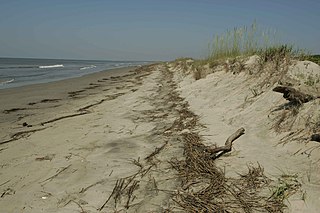
The wrack zone or wrack line is a coastal feature where organic material and other debris is deposited at high tide. This zone acts as a natural input of marine resources into a terrestrial system, providing food and habitat for a variety of coastal organisms.

Pentidotea wonsnesenskii is a marine isopod which lives on seaweed on rocky shores along the British Columbia and Washington coastlines, as far south as San Francisco. It can be as large as 40 millimetres (1.6 in) long, with a concave tail rather than an indented tail as previously shown on this page, is usually green, but its colour is adaptable to its environment. It can often be found hiding under rockweed in the intertidal zone. It is named after the Russian biologist Ilya G. Voznesensky.
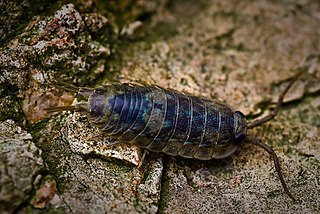
Ligia is a genus of isopods, commonly known as rock lice or sea slaters. Most Ligia species live in tidal zone cliffs and rocky beaches, but there are several fully terrestrial species in high humidity environments.

Serolidae is a family of isopod crustaceans, containing the following genera :
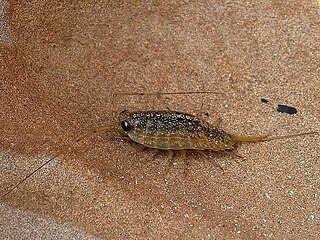
Ligia exotica, also called sea roach or wharf roach, is a woodlouse-like isopod, a sea slater in the family Ligiidae. It is found in various parts of the world living on rocky coasts and harbour walls just above high water mark.
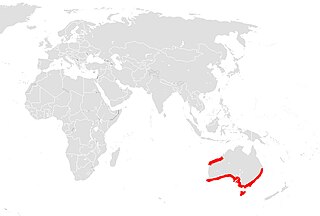
Ligia australiensis, the Australian marine slater, is a woodlouse in the family Ligiidae.
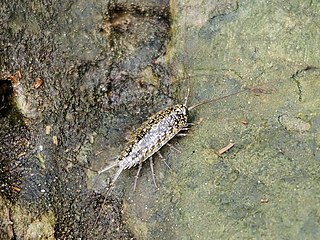
Ligia baudiniana is a woodlouse in the family Ligiidae. It has a coarsely granular surface and large eyes that are very close together.
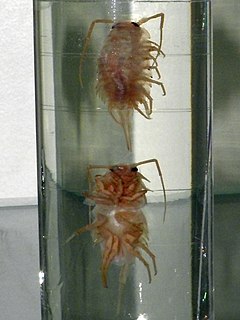
Ligia cinerascens is a woodlouse in the family Ligiidae.
Ligia natalensis is a woodlouse-like isopod in the family Ligiidae.
Ligia cajennensis is a woodlouse in the family Ligiidae. It has a relatively narrow body with a rough, grainy texture. It's a dark yellow/rust color, with lighter antennae and legs. Its eyes are brownish black.
Ligia cursor is a woodlouse in the family Ligiidae.
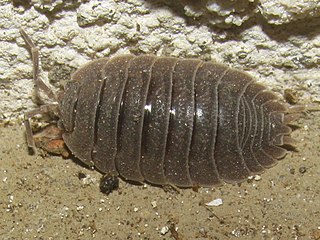
Porcellio dilatatus is a species of woodlouse in the genus Porcellio belonging to the family Porcellionidae. This species is widespread in Europe, and has also been introduced to North America from Western Europe. They are 15 millimetres (0.59 in) long, are brown coloured and striped. They can be found feeding on alder leaves, but mostly feeds on organic food substrates, such as lettuce in the wild. It also feeds on inorganic metal salts.
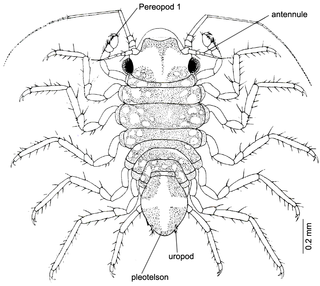
Uromunna sheltoni is a species of isopod first described by Brian Kensley in 1977. U. sheltoni is included in the genus Uromunna and family Munnidae. No subspecies are listed. The species was first collected by Peter Shelton of the University of Cape Town, for whom it is named.

Armadillidae is a family of woodlice, comprising around 80 genera and 700 species. It is the largest family of Oniscidea, and one of the most species-rich families of the entire Isopoda. Armadillids generally have a strongly convex body shape, with some rather shallowly convex. Like members of the woodlice family Armadillidiidae, armadillids are capable of enrolling into a sphere (conglobation), and are commonly known as pill bugs. Armadillids differ from the Armadillidiidae in that the antennae are fully enclosed within the sphere.

Anilocra capensis is a species of parasitic isopod in the family Cymothoidae. It is endemic to southern Africa. The species preferentially attaches itself to the hottentot.

Glyptidotea lichtensteini, the keeled isopod, is a medium-sized isopod in the family Idoteidae, found on the coast of southern Africa.
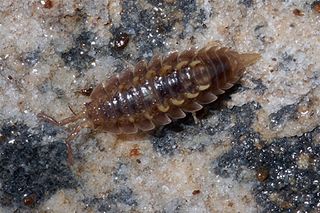
Deto echinata, the horned isopod, is a species of air-breathing isopod, or woodlouse, in the family Detonidae. It inhabits seashores in southern Africa and on some oceanic islands.

The Helderberg Marine Protected Area is a small marine conservation area on the north-eastern side of False Bay in the Western Cape province of South Africa, It lies between the mouths of the Lourens River in the Strand, and the Eerste River in Macassar.

















